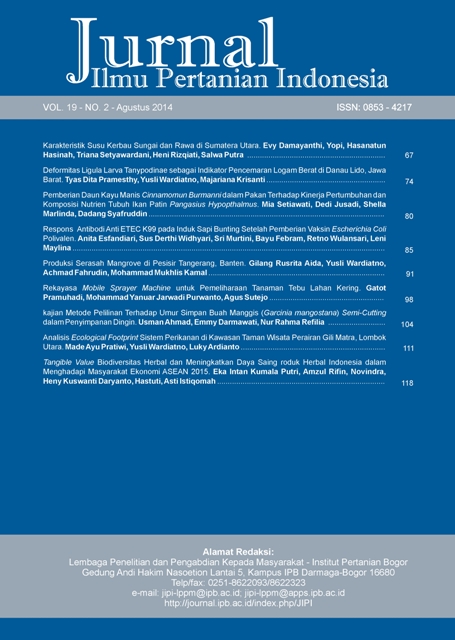Deformitas Ligula Larva Tanypodinae sebagai Indikator Pencemaran Logam Berat di Danau Lido, Jawa Barat
Abstract
As one group of Chironomidae Tanypodinae larvae can be used in biological assessment to detect the heavymetal pollution in aquatic environment, because they could show morphological changes due to the pollution. Thestudy was aimed to describe ligula deformities in Tanypodinae larvae in a heavy metal polluted lake. The study wasconducted in Mei to June 2014 at Lake Lido, West Java. The results showed that lead (Pb) concentration in LidoLake was quaite high, i.e. 0.08 0.19 mg/L. Ten of fifty-five collected Tanypodinae larve exhibited deformation in theirligulae. Index of severity of ligula deformation (ILSD) was 4.4 indicating the response of the Chironomidae larvae tolead pollution.
Downloads
References
Al-Shami S, Rawi CSM, Nor SAM, Ahmad AH, Ali A. 2010. Morphological deformities in Chironomus spp. (diptera: Chironomidae) larvae as a tool for impact assessment of anthropogenic and environmental stresses on three rivers in the juru river system, Penang, Malaysia. Environmental Entomology. 39(1): 210-222.
[APHA] American Public Health Association. 2012. Standard Methods for The Examination of Water and Wastewater 22nd Edition. American Public Health Association. Washington DC (US).
Arimoro FO, Ikomi RB, Iwegbue CMA. 2007. Water quality changes in relation to Diptera community patterns and diversity measured at an organic effluent impacted stream in the Niger Delta, Nigeria. Ecological Indicators. 7(3): 541-552.
Bhattacharya G, Sadhu AK, Mazumdar A, Chaudhuri PK. 2005. Antennal deformities of chironomid larvae and their use in biomonitoring of heavy metal pollutants in the river damodar of West Bengal, India. Environmental Monitoring and Assessment. 108(1-3): 67-84.
Bhattacharya G, Sadhu AK, Mazumdar A, Majumdar U, Chaudhuri PK, Ali A. 2006. Assessment of impact of heavy metals on the communities and morphological deformities of chironomidae larvae in the river damodar (India, West Bengal). Supplementa ad Acta Hydrobiologica. 8: 21-32.
Darmono. 1995. Logam Dalam Sistem Biologi Makhluk Hidup. Universitas Indonesia - Press. Jakarta (ID).
Effendi H. 2003. Telaah Kualitas Air: Bagi Pengelolaan Sumberdaya Dan Lingkungan Perairan. Kanisius. Yogyakarta (ID).
Epler JH. 2001. Identification manual for the larval Chironomidae (Diptera) of North and South Carolina. EPA Region 4 and Human Health and Ecological Criteria Division. Crawfordville (US).
Janssens de bisthoven LG, Timmermans KR, Ollevier F. 1992. The concentration of cadmium, lead, copper, and zinc in chironomus gr. Thummi larvae (diptera, chironomidae) with deformed versus normal menta. Hydrobiologia. 239(3): 141-149.
Jeyasingham K, Ling N. 1997. Head capsule deformities in Chironomus zealandicus (Diptera: Chironomidae): influence of site and substrate. New Zealand Journal of Marine and Freshwater Research. 31(2): 175-184.
Lagrana CC, Dahlia C, Apodaca, David CPC. 2011. Chironomids as biological indicators of metal contamination in aquatic environment. International Journal of Environmental Science and Development. 2(4): 506-510.
Michailova P, Petrova N. 2005. Comparative effect of heavy metals on the polytene chromosomes of chironomidae, dipteral. In: Proceedings The Balkan Scientific Conference Of Biology In Plovdiv (Bulgaria). Bulgaria, 19th – 21st May 2005.
Moore JW, Ramamoorthy S. 1984. Heavy Metals in Natural Waters. Springer-Verlag. New York (US).
Oliver DR, Roussel ME. 1983. The Insect And Arachnids Of Canada 11th ed: The genera of larvae midges of Canada (Diptera: Chironomidae), Biosystematics Research Institute Ottawa, Ontario. Research Branch., Agriculture Canada.
[PP] Peraturan Pemerintah. 2001. Peraturan Pemerintah Republik Indonesia Nomor 82 Tahun 2001.
Townsend KR. 2013. Using chironomidae to assess water and sediment quality. Department of Zoology Faculty of Science The University of Melbourne (AU).
Vermeulen AC, Liberloo G, Dumont P, Ollevier, Goddeeris B. 2000. Exposure of Chironomus riparius larvae (diptera) to lead, mercury and β-sitosterol: effects on mouthpart deformation and moulting. Chemosphere. 41(10): 1581-1591.
Wardiatno Y, Krisanti M. 2013. The vertical dynamics of larval chironomids on artificial substrates in Lake Lido (Bogor, Indonesia). Tropical Life Sciences Research. 24(2): 13-29.
Warwick WF. 1991. Indexing deformities in ligulae and antennae of procladius larvae (diptera: chironomidae): application to contaminant-stressed environments. Canadian Journal of Fisheries and Aquatic Sciences 48(7): 1151-1166.
This journal is published under the terms of the Creative Commons Attribution-NonCommercial 4.0 International License. Authors who publish with this journal agree to the following terms: Authors retain copyright and grant the journal right of first publication with the work simultaneously licensed under a Creative Commons Attribution-NonCommercial 4.0 International License. Attribution — You must give appropriate credit, provide a link to the license, and indicate if changes were made. You may do so in any reasonable manner, but not in any way that suggests the licensor endorses you or your use. NonCommercial — You may not use the material for commercial purposes.


















